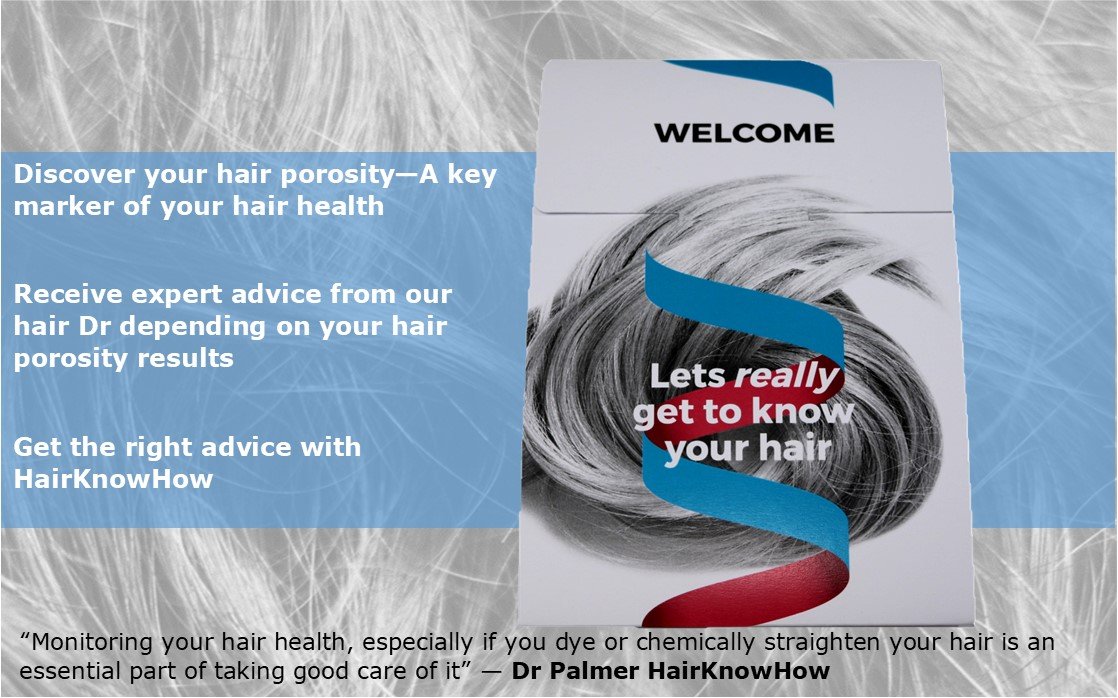Updated January 2023 By Dr Jonathan Palmer
Hair Porosity Test & Check: Understanding the Health of Your Hair
Do you ever wonder why your hair doesn’t respond as it should to certain treatments, or why your hairstyle never looks quite right, no matter what you try? The answer might be hidden in the your hair porosity, and you should get a hair porosity test.
Hair porosity is a measure of how easily moisture can enter and exit the strand.
It determines how well your hair absorbs products, how resilient it is to heat damage, and even how long styles last.
Understanding the health of your hair starts with understanding its porosity—and that’s where this article comes in handy! Read on to learn more about what it means to have high, low or normal porosity, and the best tips and tricks for managing each type.
What is hair porosity and why does it matter?
Hair porosity is determined by the structure of hair which includes both the cortex and cuticles, which is the protective outer layer of the hair shaft.
Understanding your hair porosity is crucial to ensuring the health of your hair and choosing the right hair care products.
Hair porosity can range from low to high and can affect how easily hair can be styled and how well it retains moisture, but importantly how easily it breaks and becomes frizzy.
Low porosity hair has tightly closed cuticles, making it difficult for moisture to penetrate.
High porosity hair has open cuticles, or no cuticles at all, which allows moisture to enter easily but can also lead to excessive dryness and breakage. The cortex of high porosity hair is typically full of holes and cracks.
Medium porosity hair has moderately open cuticles that allow for good moisture absorption and retention. The cortex of medium porosity hair is also likely to have some cracking and holes present.
Factors that can increase the porosity of your hair include:
Chemical hair colouring
Chemical straightening
Heat treatments - using hot irons or curling tongs
Brushing too hard
Using cleansing or sulfate containing shampoos
Brushing with metal brushes or combs
How to determine your hair porosity
There are several methods to determine your hair porosity, including:
The HairKnowHow Porosity Test: This simple to use test is sent to your home and is used accurately measure your hair porosity. HairKnowHow use powerful microscopes to look inside your hair and measure your hair porosity directly. They also include handy tips and advice that can help you manage your porosity.
The float test: Take a strand of clean, dry hair and drop it into a bowl of water. If it floats, you have low porosity hair. If it sinks, you have high porosity hair. If it sinks but then rises to the surface, you have medium porosity hair.
The slip and slide test: Run your fingers down the length of a strand of clean, dry hair. If it slides easily, you have high porosity hair. If it resists, you have low porosity hair. If it's somewhere in between, you have medium porosity hair.
The elasticity test: Gently stretch a strand of clean, damp hair. If it returns to its original length quickly and easily, you have low porosity hair. If it stretches and stays stretched, you have high porosity hair. If it stretches but returns to its original length slowly, you have medium porosity hair.
Now that you know how to determine your hair porosity, it’s important to understand what this information means for your hair health.
Low porosity hair means that your strands are resistant to moisture and won’t absorb products as easily. Low porosity hair is healthy hair, and this should be the goal of those who want the best beauty performance. This can be due to several factors, including genetics, using less processing from chemical treatments, and using little or no damage from heat styling tools.
High porosity hair means that your strands are very receptive to moisture and will absorb products easily. High porosity is generally undesirable and is heavily damaged. This can be caused by environmental factors such as excessive sun exposure or chlorine from swimming pools or by damage to the cuticle (the outermost layer of the hair). If you have high porosity hair, it is important to use products that are specifically designed to help moisturise and deep condition your hair helping it to recover.
Types of hair porosity: low, medium and high
Low porosity hair: Low porosity hair has tightly closed cuticles that make it difficult for moisture to penetrate. This type of hair is often shiny and resilient. Low porosity hair is the healthiest type of hair.
Medium porosity hair: Medium porosity hair has moderately open cuticles that allow for good moisture absorption and retention. This type of hair is considered moderately damaged and may be prone to frizziness and tangling when compared to low porosity hair.
High porosity hair: High porosity hair has widely open cuticles that allow for moisture to enter easily, but can also lead to excessive dryness and breakage. High porosity hair is often prone to frizz and can be difficult to style.
Once you know your hair porosity, you can tailor your haircare routine to meet your hair needs. For example, if you have high porosity hair, you must use products that help seal the cuticle and prevent moisture loss. If you have low porosity hair, you may need to use products that help open the cuticle so that moisture and oils can penetrate the shaft more easily, which will help reduce future damage and the rate of porosity buildup.
Factors that affect hair porosity
There are several factors that can affect hair porosity, including genetics, chemical treatments, heat styling, and environmental factors such as sun and wind exposure to name a few.
Understanding these factors can help you determine what may be causing changes in your hair porosity.
Styling Habits: Overwashing, over-brushing using sulfate-containing shampoos, heat styling—these are all things that can contribute to dry, damaged, and porous hair. Colouring your hair using chemical colouring and straightening chemistries is a big source of hair damage leading to porosity buildup. Be gentle with your locks, and give them a break every now and then!
Genetics: You can thank your parents for your hair porosity. The thickness and composition of your hair is determined by your genes. Unfortunately, if you have naturally porous hair, there’s not much you can do about it.
Diet: What you eat affects your whole body, including your hair. A diet rich in vitamins and minerals is essential for healthy hair growth. But if your diet is lacking in these nutrients, it can lead to dry, brittle, and porous hair.
Environment: The sun, wind, and cold weather can all take a toll on your hair. UV rays can cause damage to the cuticle, making it more susceptible to breakage. And exposure to chlorine or salt water can strip away the natural oils that protect and nourish your hair.
The impact of hair porosity on hair care
Your hair porosity can impact the way your hair reacts to different hair care products and treatments. For example, low porosity hair may not respond well to heavy, oil-based products, while high porosity hair may benefit from extra moisturizing treatments because moisture can easily escape, resulting in limp and lifeless hair.
Knowing your hair porosity can help you choose the right products and treatments to keep your hair healthy and looking its best.
The key to healthy hair is finding the right balance of hydration for your specific porosity level. If you have low porosity hair, you’ll want to use lighter products that won’t weigh down your strands. You should also avoid heat styling as much as possible, since this can further damage your already dry hair. High porosity hair needs heavier products to help seal in moisture. And since high porosity hair tends to be drier, you may need to shampoo more often than someone with low porosity hair.
No matter what your porosity level is, there are some general tips you can follow for healthy hair:
Use a clarifying shampoo once a month (or every two week) to remove build-up from styling products and environmental pollutants.
Deep condition regularly – at least once a week for low porosity hair and 2-3 times a week for high porosity hair.
Rinse with cold water to help seal the cuticle and lock in moisture.
Use a leave-in conditioner or serum to help protect your hair from heat styling.
Finger comb your hair instead of brushing it to reduce breakage.
Trim your hair every 6-8 weeks to help keep split ends at bay.
How to care for low porosity hair
If you have low porosity hair, here are some tips to help you care for your hair:
How to Care for Low Porosity Hair
Avoid heavy products: Low porosity hair may not respond well to heavy, oil-based products. Instead, opt for lightweight, water-based products that will hydrate your hair without weighing it down.
Avoid heat styling whenever possible: If you must use heat, be sure to use a heat protectant and use the lowest setting possible. Heat can damage low porosity hair and make it more difficult to retain moisture.
Clarify regularly: Low porosity hair can be prone to product buildup, so it's important to clarify your hair regularly to remove any excess buildup. Clarifying shampoos help to remove build-up from your hair, which can prevent moisture from being absorbed.
Pre-poo with an oil before shampooing: This will help to create a barrier on your hair so that the shampoo does not strip away all of the natural oils.
Use a deep conditioner at least once a week: Deep conditioners penetrate the cortex of the hair shaft and help to hydrate low porosity hair from the inside out. Be sure to follow up with a leave-in conditioner or cream to seal in the moisture.
Sleep with a satin scarf or bonnet on your head: This will help to prevent breakage and keep your hairstyle intact while you sleep
How to Care for Medium Porosity Hair
Use a balanced approach: Medium porosity hair is moderately damaged. Use a balanced approach, using both lightweight or heavier styling and haircare products as needed.
Use a mild shampoo and conditioner. Avoid harsh sulfates containing shampoos, that can strip away natural oils and irritate the scalp.
Use a deep conditioning treatment once or twice a week. This will help keep your hair hydrated and prevent further damage.
Avoid harsh chemicals: Chemical treatments can damage the hair cuticle and cortex and increase the porosity of your hair. Try to limit your use of harsh chemicals, such as perms and relaxers.
Use leave-in conditioners and oils to seal in moisture. This will help keep your hair looking shiny and healthy.
Use heat sparingly: While heat can be beneficial for medium porosity hair, it's important to use it sparingly to avoid damaging the hair cuticles.
Be gentle when brushing and combing your hair. Avoid excessive heat styling, which can damage your hair.
How to Care for High Porosity Hair
Hydrate regularly: High porosity hair can be prone to dryness, so it's important to hydrate your hair regularly with moisturizing treatments.
Be gentle with your hair. Avoid harsh brushing and pulling, which can further damage already fragile strands.
Use heavier products: Use products specifically designed for high porosity hair. These oil-based products help to seal in moisture and prevent further damage.
Avoid heat styling: High porosity hair is often prone to breakage, so it's best to avoid heat styling whenever possible. If you do use heat, be sure to use a heat protectant spray.
Protect your hair from the sun and wind. Use a scarf or hat when outdoors to protect your hair from the elements.
Deep condition regularly. High porosity hair benefits from regular deep conditioning treatments, which help to hydrate and reduce damage buildup.
Conclusion: Understanding hair porosity is key to healthy hair.
Maintaining healthy hair requires an understanding of your hair's porosity.
If your hair is highly porous, it will be more susceptible to damage and breakage. On the other hand, if your hair is low in porosity, it will be more resistant to damage and less likely to break.
If you're not sure what level of hair porosity you have, get a HairKnowHow Hair Porosity Test.
You can make sure that your hair feels and looks its best by determining its porosity and using the proper hair care techniques.
Remember to steer clear of harsh chemicals and excessively hot styling tools when selecting hair care products for your unique hair porosity.
Understanding your hair porosity is key to achieving healthy, beautiful hair. Knowing which treatments will work best for your particular type of porosity will help you get the most out of your haircare routine.
You can maintain healthy, beautiful hair for many years by giving it the proper care.
Get Expert Hair Analysis and Help
If you are interested in learning about hair testing or have a hair concern you would like to discuss, then please do get in touch. Contact the HairKnowHow Team if you have any questions.





